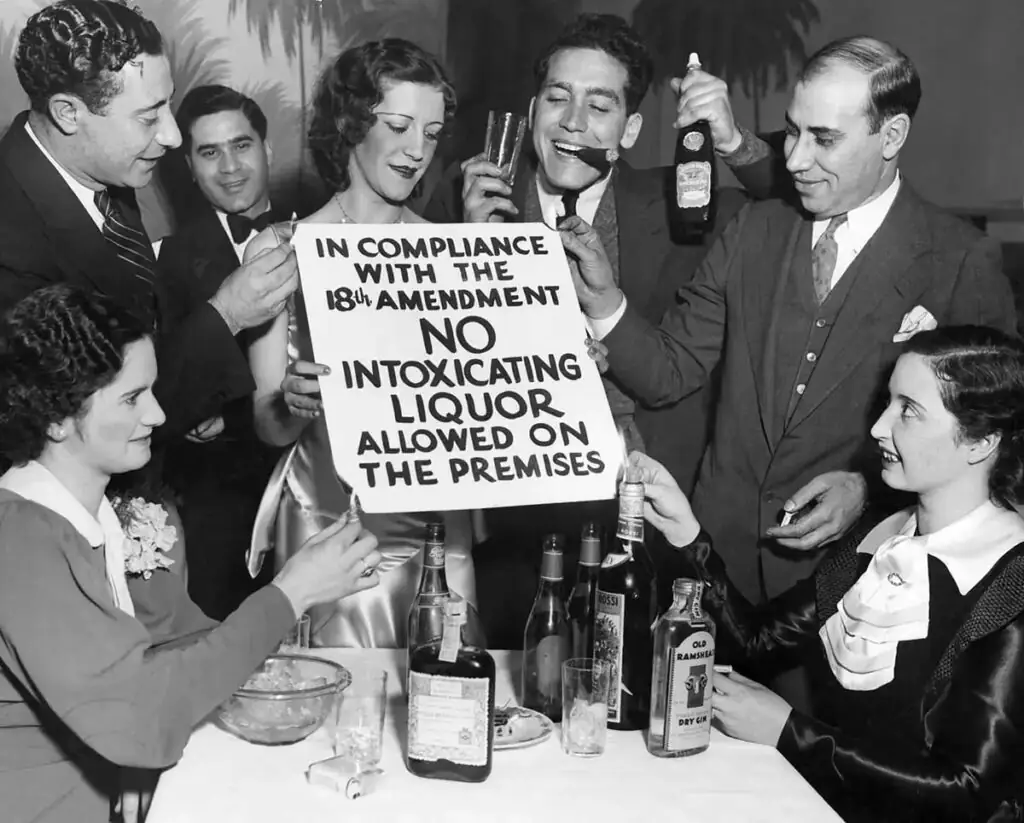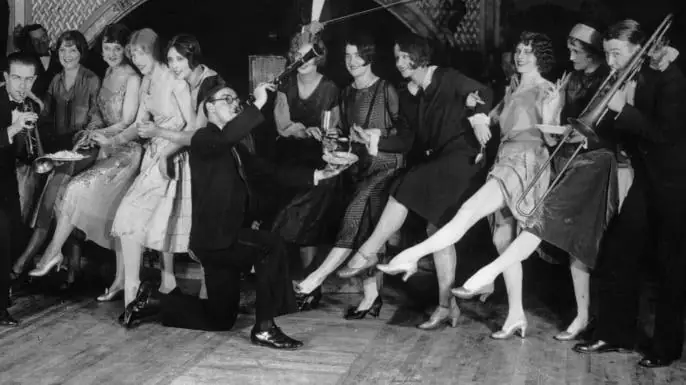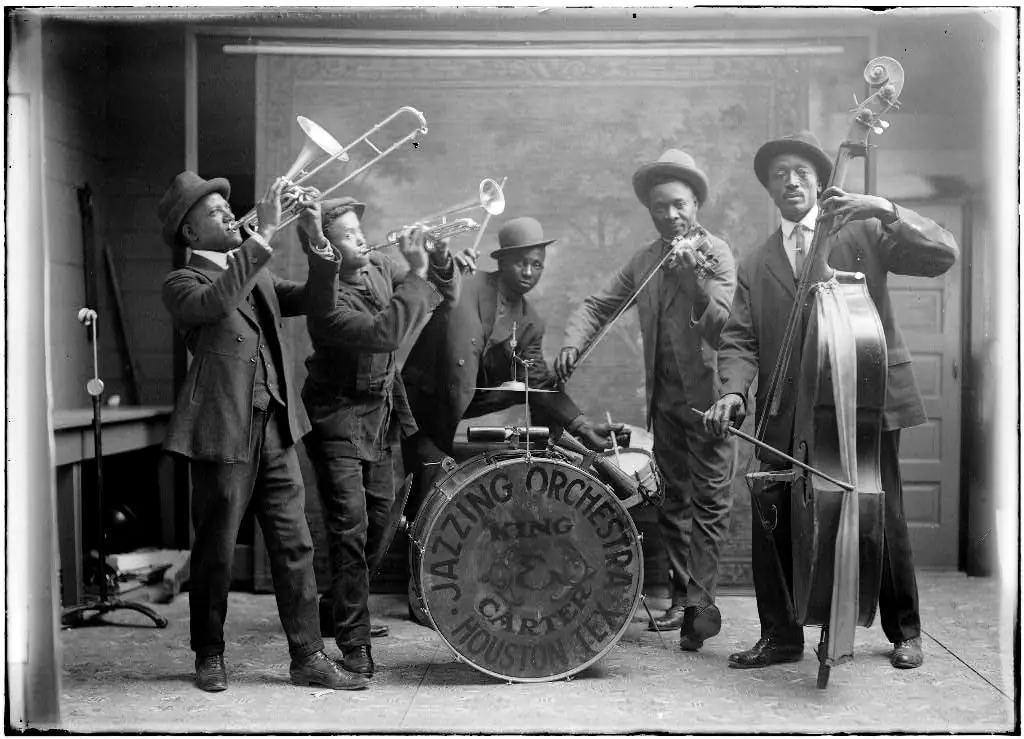The 1920s, known as the Jazz Age, was a decade of transformation in Western consumerism, marked by technological advances, changing social norms, and a distinctive culture of excess that continues to echo in modern society. This era witnessed the rise of new consumer behaviors and a culture of excess. From flappers to jazz, this decade redefined leisure, fashion, and the very concept of freedom, leaving an indelible mark on the course of history.

✅ AI Essay Writer ✅ AI Detector ✅ Plagchecker ✅ Paraphraser
✅ Summarizer ✅ Citation Generator
Alcohol Consumption in the Prohibition Era
The Prohibition era, started with the introduction of the 18th Amendment, paradoxically fueled increased alcohol consumption in the US. Despite legal restrictions, Americans found various ways to indulge in liquor, from opening speakeasies to coming to religious institutions. This defiance led to a surge in organized crime and bootlegging, profoundly impacting American society and culture.
- 🍸 Speakeasies: Covert establishments offering illegal alcohol, often hidden in basements or behind unmarked doors, serving as vibrant social hubs despite legal risks.
- 🚔 Bootlegging: The clandestine production and smuggling of liquor, a risky but rewarding business that gave rise to powerful crime syndicates.
- 💰 Organized Crime: Mafia groups and crime syndicates thrived, amassing wealth and influence by controlling the illicit alcohol trade.

The New Woman of the 1920s
The 1920s saw the birth of flappers, young women who embraced unprecedented freedom in fashion, behavior, and lifestyle. Defying traditional norms, flappers symbolized the era’s spirit of liberation, with their bold dressing choices and vibrant participation in social life, including popular dances like the Charleston.
- 💃 Fashion: Flappers wore short, fringed dresses that symbolized liberation from restrictive clothing, along with bobbed hairstyles that defied traditional femininity.
- 🚬 Lifestyle: Embracing smoking, partying, and sexual freedom, flappers represented a radical shift in women’s social behavior, often frequenting jazz clubs and engaging in what was then considered scandalous behavior.
- 🎶 Dance: The Charleston, a lively and expressive dance, became synonymous with flappers, becoming a reflection of their spirited and unconventional nature.

The Decade of Debauchery: Parties and Excess
The main thing about the roaring 1920s was that these years were defined by extravagant parties (one of the reasons, aside from cars and jazz, why the name ‘roaring’) and a fast-paced lifestyle, as depicted in F. Scott Fitzgerald’s “The Great Gatsby.” This period saw the rise of the “Bright Young Things” in London, characterized by their lavish and often scandalous behavior, mirroring the Flappers in the US.
- 🥳 Parties: Characterized by opulence and extravagance, these parties were legendary for their scale and the carefree attitude of their attendees.
- 🍾 Lifestyle: Marked by excessive drinking, recreational drug use, and a libertine approach to sex and relationships.
- 📰 Media Attention: The outrageous lifestyles of these groups were a constant source of fascination and scandal in the tabloid press, reflecting a growing celebrity culture.

The Changing Consumerism in the Roaring Twenties
The 1920s had a significant shift in consumer habits, with the widespread adoption of new technologies like automobiles and radios. This era also saw the flourishing of the arts, including jazz music and Art Deco, showing a broader cultural and economic transformation.
- 🚗 Automobiles: Cars became symbols of personal freedom and social status; models like the Ford Model T were affordable for the middle class, revolutionizing transportation.
- 📻 Radios: Radios became central to family entertainment, offering news, music, and serialized dramas, thereby uniting the nation through shared experiences.
- 🎨 Arts: Jazz, with its lively rhythms, became the era’s soundtrack, while Art Deco’s bold geometric shapes and vibrant colors influenced architecture and design.
The Economic Crash
The excesses of the 1920s culminated in the Wall Street Crash of 1929, leading to the Great Depression. This period highlighted the fragility of the era’s economic prosperity and marked a significant shift in social and cultural dynamics.
- 💥 Wall Street Crash: The catastrophic collapse of the stock market erasewd great amounts of wealth and triggered a global economic crisis.
- 📉 Economic Impact: The crash led to widespread unemployment, home foreclosures, and a general decline in living standards, affecting millions of people worldwide.
- 🌐 Global Effect: The economic downturn quickly spread globally, leading to economic hardships and political upheaval in many countries.
The Roaring Twenties’ Enduring Legacy
A century later, the Roaring Twenties continue to influence modern culture and society. The decade’s blend of social change, technological innovation, and cultural dynamism remains a reference point for understanding contemporary trends and challenges.
- 🎷 Jazz Influence: Jazz music, born out of African American communities, became a global phenomenon, influencing various music genres and cultural expressions.
- 🏙️ Architectural Legacy: Art Deco architecture, with its emphasis on modernity and elegance, left a lasting imprint in cities worldwide.
- 📚 Literary Impact: Novels like “The Great Gatsby” continue to be celebrated for their portrayal of the era’s extravagance and the pitfalls of the American Dream.

The 1920s, a decade of dramatic change and cultural dynamism, left a grand impact on consumerism and society. Its legacy continues to resonate, offering insights into the complexities of modern culture.
FAQ
Follow us on Reddit for more insights and updates.





Comments (0)
Welcome to A*Help comments!
We’re all about debate and discussion at A*Help.
We value the diverse opinions of users, so you may find points of view that you don’t agree with. And that’s cool. However, there are certain things we’re not OK with: attempts to manipulate our data in any way, for example, or the posting of discriminative, offensive, hateful, or disparaging material.